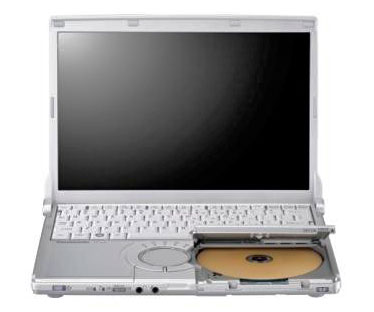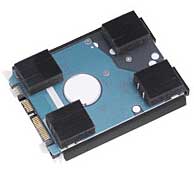|
Panasonic Toughbook S10
Panasonic's practical business-rugged ultra-light gets a tech update
(by Conrad H. Blickenstorfer)
When it comes to computers, Panasonic, or rather the Panasonic Solutions Company, is primarily known for its rugged Toughbook notebooks and tablets in the United States. However, while it usually is the big, bad Toughbook 31, the convertible Toughbook 19, and some of Panasonic's other hardened products that are in the limelight, the company also has a whole line of what they call "business-rugged" notebooks. Those are really Japanese domestic market "Let's Note" models that come in a variety of product lines with displays ranging from 10.1 to 15.6 inches.
Let's Note notebooks have a style of their own, and they are several notches above your average consumer notebook in terms of quality and durability. Over the years, Panasonic has sold some of the Let's Note models in the US under the Toughbook brand name.
While in Japan there are currently B, C, J, N and S series models, US customers can only get C, F, S and T versions. Letter designations seem to come and go, and models change frequently, so it isn't easy to keep track of the lineup. Which is kind of unfortunate because they are all fascinating machines that deserve a lot more attention.
As is, on August 10, 2011, Panasonic introduced the Toughbook S10 in the US. The new model replaces the older S9, which at some point replaced earlier W-Series models (see what we had to say about the Toughbook W8).

Business-rugged?
First, what does "business-rugged" mean? In Panasonic's terminology, it describes notebooks that are designed for mobile professionals and road warriors who require machines that can handle the stress of frequent travel and constant movement. Panasonic's business rugged computers use some of the same technology as their semi-rugged and fully rugged machines, such as a magnesium alloy case, shock-mounted hard drive, spill-resistant keyboard, and flexible internal connectors. However, they are built to handle minor spills and drops as opposed to a passing a checklist full of military specs.
In terms of overall concept, the S10 is the latest in a long line. There was a sequence of "W" Series notebooks starting with the Pentium M powered W2 quite a few years ago ("Let's Note" laptops have been around for 15 years now) that was then replaced by the very similar W4, then the slightly upgraded W5, W7 and W8. Size and concept always stayed the same, but each new generation received technology updates and generally a bit more battery power. For some reason, the designation then switched to "S," but the new machine definitely carries on the torch of Panasonic's 12.1-inch, optical drive-equipped models.
Distinctly Japanese design
What that means is a machine with a distinctly Japanese design that's very different from, say, an Apple MacBook Air. While the S10's 11.1 x 8.3 inch footprint is very compact, it is thicker and bulkier than the super-slender Apple machine, though at 3.0 pounds the S10 doesn't weigh much more. The S10's relative heft is in part explained by its astoundingly powerful 92 watt-hour battery. That's more watt-hours than you get almost anywhere, and it means that the S10 can run a full 12.5 hours on a charge (the usually more conservative Japanese specs even boast 16.5 hours). And then there's the super-multi optical drive, and more ports than any Apple notebook ever had.
The S10's 12.1-inch display offers 1280 x 800 pixel resolution, which means a 16 : 10 wide format aspect ratio. No touch screen here, but the unique and very precise circular touch pad provides some interesting extra functionality. Like its predecessors, the S10 has a precision-engineered, metallic high-tech look to it. The 83-key keyboard is full-scale, which is certain to be appreciated by touch-typists. Letters and symbols are dark gray on very light gray and easy to read.
What's new?
Compared to the S9 that it replaces, the S10 represents a relatively minor, though much appreciated update. The 2.4GHz Intel Core i5-520M processor has given way to a 2.5GHz Core i5-2520M that's part of the 2nd Generation of i5 chips (the first one is now called "Previous Generation Intel Core i5"), and the complementing chipset is new as well. There's now a USB 3.0 port in addition to two USB 2.0 ports. WiFi is slightly upgraded with the latest Intel Centrino Advanced-N 6205, RAM now starts at 4GB instead of just 2GB, and can be increased to 8GB instead of 6, and battery life received the aforementioned boost. Everything else appears to be more or less the same, which isn't bad. Anyone who always liked the W/S Series machines will appreciate the updates. Those who consider the design too big, bulky and expensive will continue to pass.
Ruggedness
Since the Panasonic S10 is part of the Toughbook line, questions about its ruggedness will come up again and again, and so "business-rugged" needs to be defined a bit more. As soon as you pick up any W or S model, you realize that while it may have a magnesium case, this is not the same type of construction you find on a fully rugged Toughbook CF-31. Everything is much lighter and thinner. Here, magnesium is used for strength, just not as much as the big Toughbooks.  It can survive a 30 inch drop, though depending on the surface, probably not without a scratch. The hard disk has massive padding and should be safe no matter what. It can survive a 30 inch drop, though depending on the surface, probably not without a scratch. The hard disk has massive padding and should be safe no matter what.
As far as sealing against dust and water goes, the S10 is not rated at all. The ports are all open and have no plugs. That's because this machine was not designed to pass MIL-STD tests for dust and water protection. Instead, Panasonic built these machines so they can survive the biggest threat in a business environment: a drink spilled on it. You can spill six ounces of liquid onto the keyboard, and the S10 won't get damaged. So this is a Toughbook, but one that only weighs three pounds and can only take that much punishment.
Bottom line
We've always liked the Toughbook W and S Series, all the way back to initial W2. The line combines small size, light weight, and now excellent performance with very long battery life. There's the onboard optical drive and the S10 excels in the connectivity and wireless departments. It is very competently designed and brings the Toughbook brand into business. This latest iteration now uses Intel's very latest Core i5 chips as well, so we're technologically up-to-date, at least processorwise.
The drawbacks remain the same: in an era where everything is ever slimmer and more elegant, the S10 seems needlessly thick and bulky. If that is not an issue, this latest S Series Toughbook remains a reliable and versatile, albeit rather expensive, performer with great utility and superior battery life.
|



